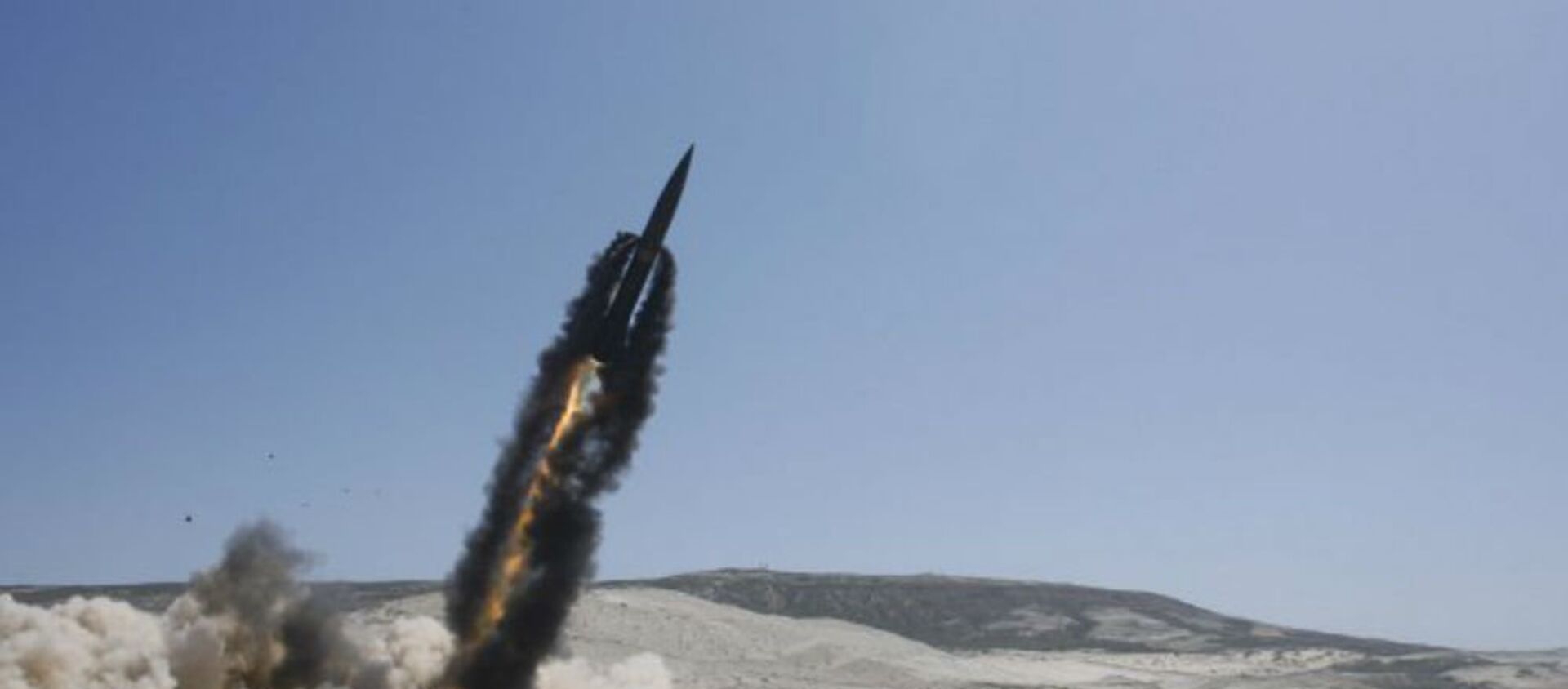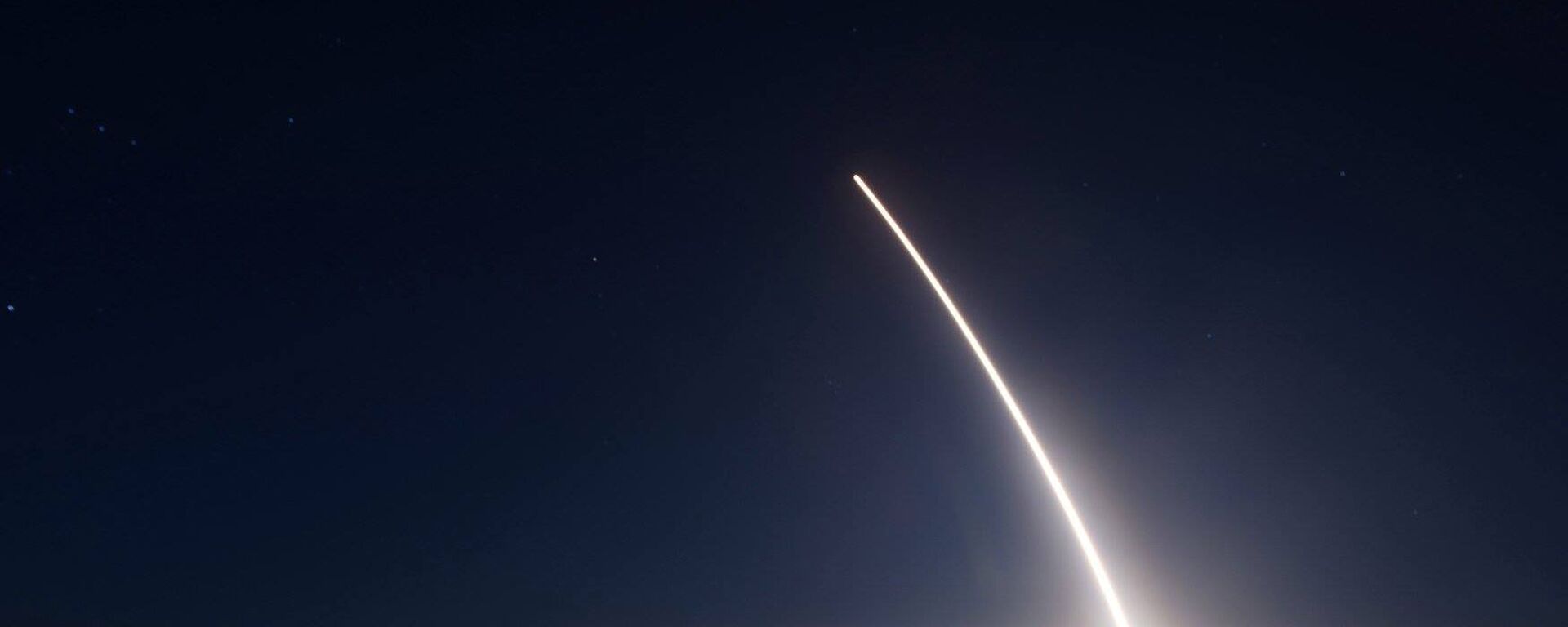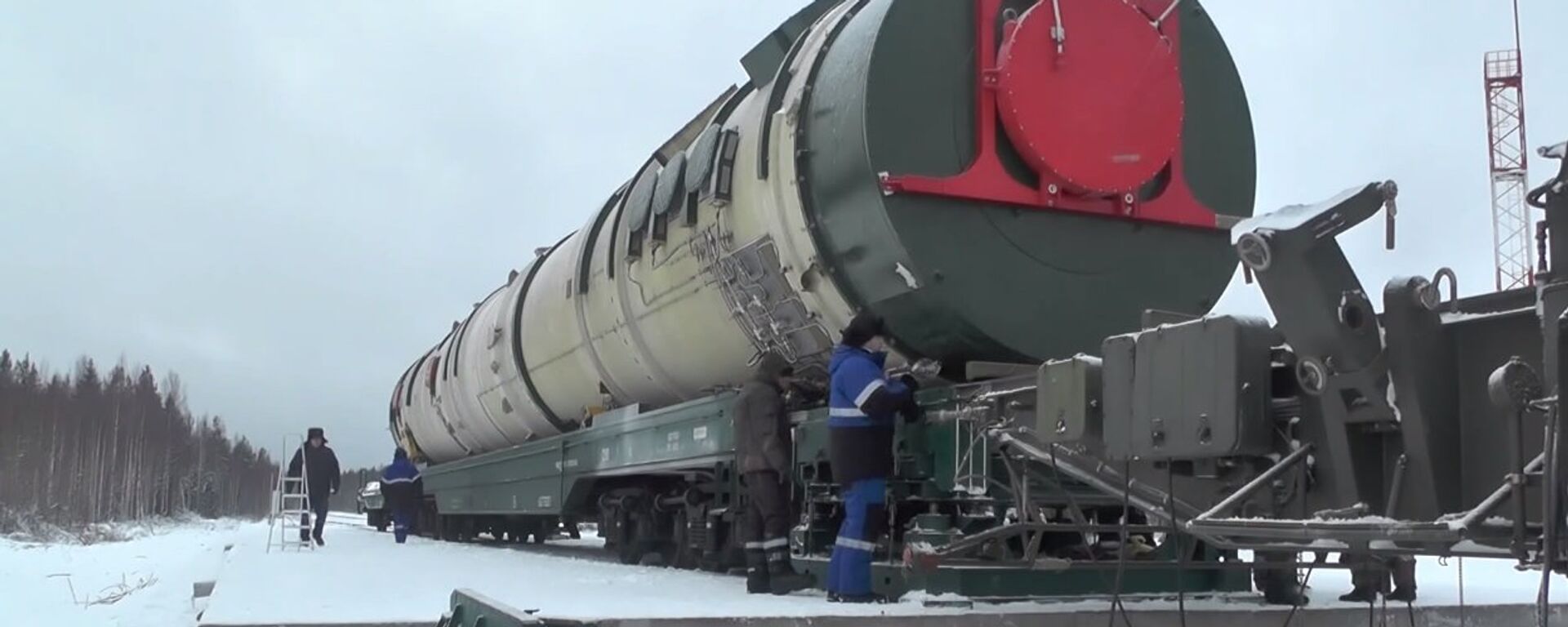https://sputnikglobe.com/20230622/what-is-the-sarmat-missile-and-why-does-western-media-call-it-the-satan-ii-1111399194.html
What is the Sarmat Missile, and Why Does Western Media Call It the ‘Satan II’?
What is the Sarmat Missile, and Why Does Western Media Call It the ‘Satan II’?
Sputnik International
The intercontinental ballistic missile (ICBM) is expected to become the backbone of Russia’s silo-based strategic deterrent. What are its characteristics? Why has the West given it such a creepy name? And why do Russian military planners hope that the strategic weapon will never be used? Sputnik explains.
2023-06-22T13:27+0000
2023-06-22T13:27+0000
2023-06-22T13:34+0000
military
vladimir putin
russia
ukraine
yuzhmash
nato
sarmat
icbms
minuteman
https://cdn1.img.sputnikglobe.com/img/106322/95/1063229504_0:16:1531:877_1920x0_80_0_0_6287e66eeff49ca8f3f2bc38045d305f.jpg
Russia’s Sarmat missile is in the news again. On Wednesday, Russian President Vladimir Putin announced that the first Sarmat launchers featuring what he said was a “new heavy missile” would go on combat duty “in the near future.”Putin did not elaborate, except to say that Russia would continue to develop its nuclear triad, which he said would serve as a “key guarantee of Russia’s military security and global stability.”Western media immediately jumped on his comments, with one outlet going with the headline “Putin intimidates Ukraine and world with super-heavy ICBMs again, promising to deploy them on combat duty,” and a major British tabloid decking out its title with scary verbs and adjectives such as “warns” and “terrifying,” using the term “Satan II,” and pointing out that the Sarmat “can allegedly reach the UK in just three minutes from Russia.”What is the Sarmat?The RS-28 Sarmat is Russia’s next-generation silo-based, three-stage, liquid-fueled, multiple independently targetable reentry vehicle (MIRV)-equipped ICBM. The missile has an operational range of up to 18,000 km, enough to target almost any spot on Earth, and can reportedly be equipped with 10-15 warheads, up to two dozen Avangard hypersonic glide vehicles, or a combination of warheads and countermeasures, including dummy warheads to distract and fool enemy missile defenses.Initial development work on the Sarmat was begun in 2011 by the Makeyev Design Bureau, accelerating in 2014 after the Maidan coup d’état in Kiev, which cut Russia off from cooperation with Ukraine’s military-industrial complex – whose Yuzhnoye Design Bureau and Yuzhmash aerospace giants had been tasked with the creation of heavy, long-range strategic missiles in Soviet days.The Sarmat is designed to replace the R-36M2 Voyevoda missile – a modification of the R-36 family of ICBMs and space launch vehicles that was developed in the 1960s, and whose upgraded Voyevoda variant was first introduced into service in 1988.The new heavy missile has been touted as the Russian response to Prompt Global Strike – the highly ambitious (and dangerous) concept thought up by Pentagon planners proposing preemptive conventional massed cruise missile strikes to disarm an adversary and decapitate its leadership. The PGS concept, unveiled shortly after the US withdrew from the Antiballistic Missile Treaty with Russia in 2002, pushed Moscow to dust off plans for the creation of a range of advanced weapons, including hypersonic missiles and glide vehicles, and eventually the Sarmat, all in an effort to prevent American military leaders from ever being able to conclude that the US could launch a surprise attack against Russia, conventional or otherwise, without evoking a devastating and potentially world-ending response.The Bulletin of the Atomic Scientists estimates that each of the Sarmat’s warheads have an explosive power of up to 500 kilotons – enough to completely level a major metropolitan area. For comparison, the US nuclear attacks on Hiroshima and Nagasaki in August 1945 had an explosive power of ‘just’ 15 and 21 kilotons, respectively, but destroyed both cities and killed over 225,000 people.What is Sarmat’s Name a Reference to, and Why Do Western Media Call It ‘Satan II’?The Sarmat is named after the Sarmatian peoples – the confederation of ancient Eastern Iranian equestrian nomads thought to have lived in the Pontic-Caspian steppe in southern Russia and Ukraine from the 3rd century BC to the 4th century AD, and known for their advanced culture, use of technology, and woman warrior code.NATO designates the Sarmat as the ‘SS-X-29’ or ‘SS-X-30’ missile, but Western media often call it the ‘Satan II’, presumably over the term's terrifying associations with evil and suffering. The ‘Satan II’ nomenclature actually comes from the NATO reporting name ‘SS-18 Satan’ used for the R-36M missile, the missile system the Sarmat is set to replace, but is never used by the Russian military.When Will the Sarmat Come Online?The Sarmat was successfully test launched by the Russian military from the Plesetsk Cosmodrome in April 2022, with a state contract on the missiles’ manufacture signed in August, and mass production starting in November. Produced by the Krasnoyarsk Machine-Building Plant (KrasMash), the first Sarmat missiles are presently expected to be delivered to the military and to start combat duty before the end of 2023.What is the US Analogue to the Sarmat?The United States presently has no analogue to the Sarmat, with its Minuteman LGM-30 silo-based ICBMs having an operational range of up to 13,000 km, a throw weight of between 170 and 335 kilotons, and up to three MIRVs, with Washington preferring to keep its heaviest nuclear firepower stationed aboard its fleet of nuclear-armed submarines. The US does not have the same kinds of restrictions on nuke use as Russia does, with the Biden administration's 2022 Nuclear Posture Review allowing for nuclear first use, and even nuclear attacks even against non-nuclear weapons states.
https://sputnikglobe.com/20230405/russian-diplomat-not-ruling-out-new-start-doomed-says-chances-of-its-restoration-little-1109152252.html
https://sputnikglobe.com/20160214/us-pgs-endangers-strategic-stability-1034758287.html
https://sputnikglobe.com/20221213/21-years-ago-today-us-rips-up-abm-treaty-with-russia-starting-slow-slide-toward-current-crisis-1105420298.html
https://sputnikglobe.com/20220907/us-test-launches-minuteman-iii-missile-to-show-nuclear-force-readiness-air-force-1100491052.html
russia
ukraine
Sputnik International
feedback@sputniknews.com
+74956456601
MIA „Rossiya Segodnya“
2023
News
en_EN
Sputnik International
feedback@sputniknews.com
+74956456601
MIA „Rossiya Segodnya“
Sputnik International
feedback@sputniknews.com
+74956456601
MIA „Rossiya Segodnya“
sarmat, missile, icbm, intercontinental ballistic missile, strategic missile, strategic deterrence
sarmat, missile, icbm, intercontinental ballistic missile, strategic missile, strategic deterrence
What is the Sarmat Missile, and Why Does Western Media Call It the ‘Satan II’?
13:27 GMT 22.06.2023 (Updated: 13:34 GMT 22.06.2023) The Sarmat intercontinental ballistic missile (ICBM) is expected to become the backbone of Russia’s silo-based nuclear deterrent. What are its characteristics? Why has the West given it the creepy name of 'Satan II'? And why do Russian military planners hope that the strategic weapon will never have to be used? Sputnik explains.
Russia’s Sarmat missile is in the news again. On Wednesday, Russian President Vladimir Putin
announced that the first Sarmat launchers featuring what he said was a “new heavy missile” would go on combat duty “in the near future.”
Putin did not elaborate, except to say that Russia would continue to develop its nuclear triad, which he said would serve as a “key guarantee of Russia’s military security and global stability.”
Western media immediately jumped on his comments, with one outlet
going with the headline “Putin intimidates Ukraine and world with super-heavy ICBMs again, promising to deploy them on combat duty,” and a major British tabloid
decking out its title with scary verbs and adjectives such as “warns” and “terrifying,” using the term “Satan II,” and pointing out that the Sarmat “can allegedly reach the UK in just three minutes from Russia.”
The RS-28 Sarmat is Russia’s next-generation silo-based, three-stage, liquid-fueled, multiple independently targetable reentry vehicle (MIRV)-equipped ICBM. The missile has an operational range of up to 18,000 km, enough to target almost any spot on Earth, and can reportedly be equipped with 10-15 warheads, up to two dozen Avangard hypersonic glide vehicles, or a combination of warheads and countermeasures, including dummy warheads to distract and fool enemy missile defenses.
Initial development work on the Sarmat was begun in 2011 by the Makeyev Design Bureau, accelerating in 2014 after the Maidan coup d’état in Kiev, which cut Russia off from cooperation with Ukraine’s military-industrial complex – whose Yuzhnoye Design Bureau and Yuzhmash aerospace giants had been tasked with the creation of heavy, long-range strategic missiles in Soviet days.
The Sarmat is designed to replace the R-36M2 Voyevoda missile – a modification of the R-36 family of ICBMs and space launch vehicles that was developed in the 1960s, and whose upgraded Voyevoda variant was first introduced into service in 1988.
The new heavy missile has been touted as the Russian response to Prompt Global Strike – the highly ambitious (and dangerous) concept thought up by Pentagon planners proposing preemptive conventional massed cruise missile strikes to disarm an adversary and decapitate its leadership. The PGS concept, unveiled shortly after the US withdrew from the Antiballistic Missile Treaty with Russia in 2002, pushed Moscow to dust off plans for the creation of a range of advanced weapons, including hypersonic missiles and glide vehicles, and eventually the Sarmat, all in an effort to prevent American military leaders from ever being able to conclude that the US could launch a surprise attack against Russia, conventional or otherwise, without evoking a devastating and potentially world-ending response.

14 February 2016, 22:19 GMT
The Bulletin of the Atomic Scientists
estimates that each of the Sarmat’s warheads have an explosive power of up to 500 kilotons – enough to completely level a major metropolitan area. For comparison, the US nuclear attacks on Hiroshima and Nagasaki in August 1945 had an explosive power of ‘just’ 15 and 21 kilotons, respectively, but destroyed both cities and killed over 225,000 people.
Russia’s nuclear doctrine restricts the use of nuclear weapons to a retaliation to a major enemy attack using weapons of mass destruction, or a conventional attack so severe that the integrity of the state is deemed to be at stake. That means Russia won’t ever use its Sarmats, or any of its other nuclear weapons, tactical and strategic, unless such a grave threat exists.
What is Sarmat’s Name a Reference to, and Why Do Western Media Call It ‘Satan II’?
The Sarmat is named after the Sarmatian peoples – the confederation of ancient Eastern Iranian equestrian nomads thought to have lived in the Pontic-Caspian steppe in southern Russia and Ukraine from the 3rd century BC to the 4th century AD, and known for their advanced culture, use of technology, and woman warrior code.
NATO designates the Sarmat as the ‘SS-X-29’ or ‘SS-X-30’ missile, but Western media often call it the ‘Satan II’, presumably over the term's terrifying associations with evil and suffering. The ‘Satan II’ nomenclature actually comes from the NATO reporting name ‘SS-18 Satan’ used for the R-36M missile, the missile system the Sarmat is set to replace, but is never used by the Russian military.

13 December 2022, 13:36 GMT
When Will the Sarmat Come Online?
The Sarmat was successfully test launched by the Russian military from the Plesetsk Cosmodrome in April 2022, with a state contract on the missiles’ manufacture signed in August, and mass production starting in November. Produced by the Krasnoyarsk Machine-Building Plant (KrasMash), the first Sarmat missiles are presently expected to be delivered to the military and to start combat duty before the end of 2023.
What is the US Analogue to the Sarmat?
The United States presently has no analogue to the Sarmat, with its Minuteman LGM-30 silo-based ICBMs having an operational range of up to 13,000 km, a throw weight of between 170 and 335 kilotons, and up to three MIRVs, with Washington preferring to keep its heaviest nuclear firepower stationed aboard its
fleet of nuclear-armed submarines. The US
does not have the same kinds of restrictions on nuke use as Russia does, with the Biden administration's 2022 Nuclear Posture Review allowing for nuclear first use,
and even nuclear attacks even against non-nuclear weapons states.

7 September 2022, 11:00 GMT






